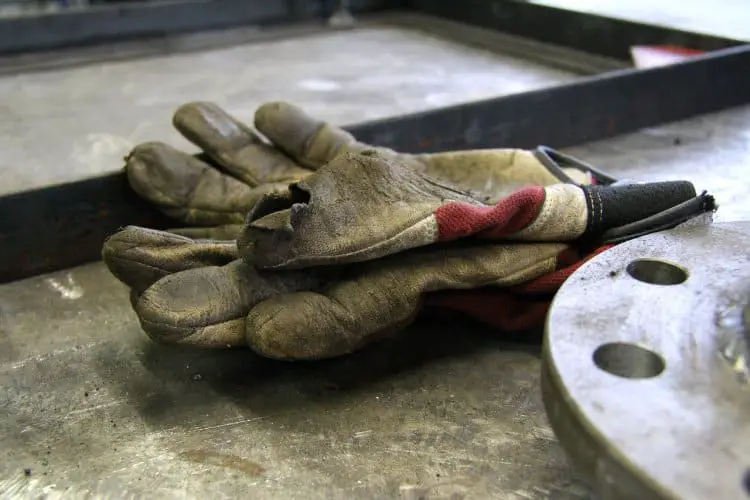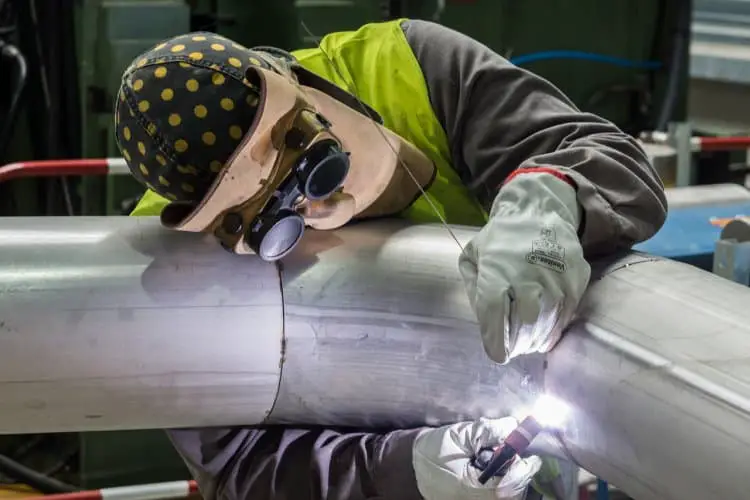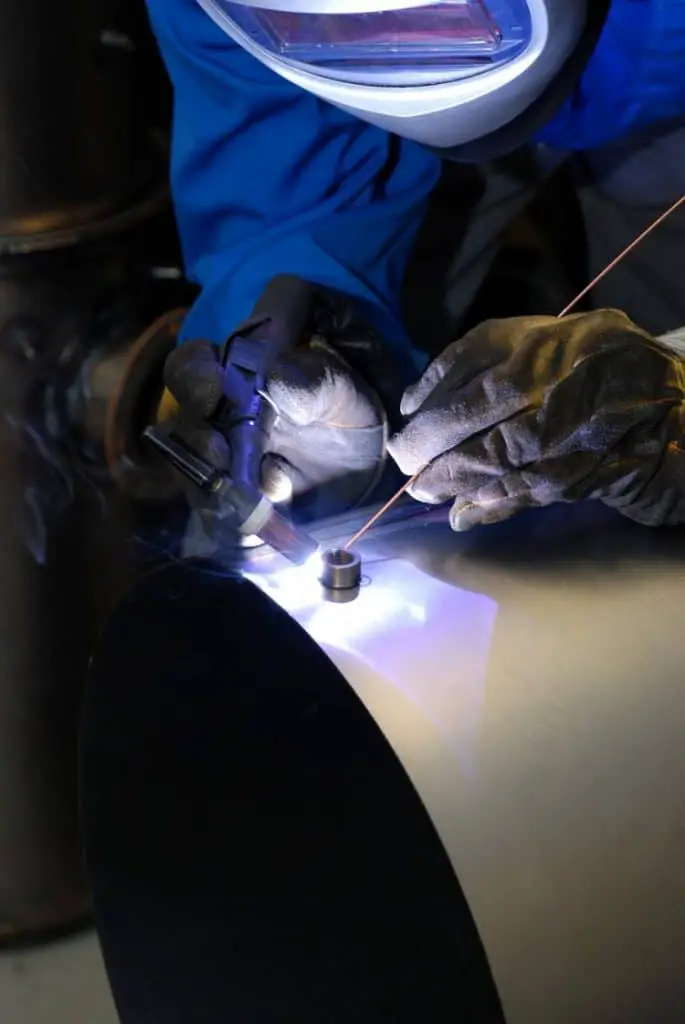This post contains affiliate links to products, services, or education. We may receive a commission for purchases made through links.
When our window railings rusted out early this year, the first thing I did was borrow my brother-in-law’s welding machine. I couldn’t find any welding gloves, however. Since I didn’t want to burn my hands, I decided to get some. And since I didn’t want to throw my money away on second-rate gloves, I went in search of high-quality gloves.
Can you use leather gloves for welding? Yes. In fact, leather is the best material for welding gloves because it is very durable while also being heat- and flame-resistant.
You should know what to look for in the best welding gloves available right now and why it should have leather as its primary material. We touched on this a bit in a previous post titled Are Welding Gloves Heat Resistant. Here is a more in-depth look specifically at leather gloves.

Why is Leather an Excellent Material for Welding?
Heavy materials such as leather, wool, or heavy cotton provide you with better protection than other materials. These materials are also very durable, allowing you to save money in the long run since you would need fewer replacements. Leather is also non-conductive to electricity.
Types of Leather Used for Welding Gloves
The leather used in welding gloves comes from a variety of animals, as explained by Engineering 360. Different types of leather are used for various welding jobs. The leather used typically comes from the hides of deer, elk, goat, swine, cow, and other animals.
What should you know about each type of animal hide used in making leather?
- Cowhide – Resistant to abrasion and very durable
- Goat – Stronger and more durable than most other animal hides
- Deer – Soft, flexible, and comfortable to wear
- Elk – Combines softness and durability
- Pig – Porous texture of the hide makes it very durable
Depending on what type of hide is used, leather gives you varying degrees of comfort and durability. There is, however, a trade-off when it comes to these two qualities: the more comfortable the leather welding gloves, the less durable they are.
What kind of leather is Ideal for Different Welding Jobs?

TIG Welding Gloves
TIG welding is a method of welding that uses tungsten inert gas. Others call it gas tungsten arc welding.
TIG welding is often used when you want to join light metals or alloy steel together. You need higher finger sensitivity for this method. TIG welding gloves are usually made with pig, cow, or goat hides.
MIG Welding Gloves
Metal inert gas welding needs gloves that provide some dexterity and maximum protection. These gloves are usually made with deer, cow, or pig hides.
Stick Welding Gloves
Stick welding requires the use of gloves made from elk or cowhide. This is because you need maximum protection from burns, heat, and electric shocks.
The Cut
There are two types of leather gloves for welding. These are based on the cut of the cow.
MIG and TIG welding requires a grain cut. Grain leather is the smooth outside portion of the hide. As such, it is more flexible.
Stick welding requires split leather, which is the inner side of the hide. This makes it very durable and able to provide the most protection.
How to Choose the Right Leather Gloves for Welding
Welding gloves need to guarantee that you will be protected from skin burns caused by radiation, spatter, or sparks.
According to the Industry Safety and Hygiene News, your welding gloves should be flame-resistant. This quality ensures that the gloves do not catch fire even as you get splatters on it. This will help you avoid getting the gloves burned and the fire reaching the insulation in the lining.
Additionally, the ANSI welding safety standards recommend gloves that give you protection from the heat. Your hands are the closest to the objects that are being welded. A good welding glove will keep your hands cool while working.
Overall, protective clothing such as welding gloves should give ample coverage. Therefore, a good pair of welding gloves should cover your fingers, wrist, and any other part of your lower arm that is exposed.
Nice to Have: Qualities That Can Help You Decide on One Pair over Another
Aside from giving you the right mix of the durability and dexterity you need, welding gloves should also provide sufficient coverage and maximum protection. As personal protective equipment, welding gloves are subject to several standards.
However, there are several things that you might want to look for in the best leather gloves for welding.
- Welding gloves may dry out over time because of it being exposed to very high temperatures. This makes them susceptible to tearing. Over time they will become brittle.
- The first part to fail when it comes to gloves is the part where you grasp the weld gun. This is right along the trapezium bone, near the area where your thumb and index finger meet. Check for additional leather in this area. That is designed to make the gloves more durable. You should also check for Kevlar seams, which make the stitching more durable as well.
Well-designed gloves will also have insulation on the inside. Remember that insulation materials such as foam or fleece are highly flammable. The most commonly used insulation include:
- Foam: Lightweight and cushions your hands
- Kevlar: Very versatile and durable
- Jersey: Affordable and provides protection from moderate heat
- Thinsulate: Best material for insulation
- Pile: Soft material
- Wool: Good insulation and dries fast
Lastly, buy gloves that fit you well and are comfortable to wear. Avoid those gloves that are one-size-fits-all. A better and comfy fit will help you have more control of your welding tools.
Precautions and Tips When Choosing Leather Gloves
Clothing used in welding is treated with flame- and heat-resistant materials. Leather can easily withstand temperatures of up to 400 degrees Fahrenheit, but some gloves are treated with chromium oxide to make them more heat-resistant.
Also, check to see if you are buying genuine leather gloves and not faux leather. Synthetic leather might be flammable and should not be used for welding jobs.
Underwater welders and other welders working in hazardous and hostile environments need a different kind of leather gloves for welding. Depending on what you need, there are gloves with premium features such as those that are moisture- and dust-resistant, as well as those that are brightly colored.
Best Leather Gloves for Welding

If you are looking for the best leather gloves for welding, here are some of our recommendations.
1. Best for TIG Welding: Revco T50 Welding Gloves
The Revco T50 uses premium grain goatskin that allows you to be more in control of your fingers’ movement while also being protected from the heat and flames.
2. Best for MIG Welding: Tillman 875 Premium Top Grain Elk Welding Gloves
Made with top-grain Elk hide, these gloves are soft and flexible. They are also heat -resistant. You can spend hours and hours doing MIG welds with this pair.
3. Best for Stick Welding: Caiman 1878 Welding Gloves
Made with the best deerskin and boar hide, these gloves can protect your hands for the heat. Their comfortable fit and dexterity make them perfect for those stick welding sessions.
This pair is 21 inches long, which makes it ideal for those who want to protect not just their hands but their forearms as well.
Welding Hand PPE Conclusion
Welding without the proper personal protective equipment can be hazardous. Welding without gloves, even for those quick jobs, is dangerous because you are handing very hot objects.
The best leather glove for welding depends on what method or what welding job you’re doing. Generally, however, it should provide you with heat and flame protection that helps you avoid burns.
The good news is that there are a variety of materials, cuts, and sizes to choose from at prices that will make your wallet smile.

